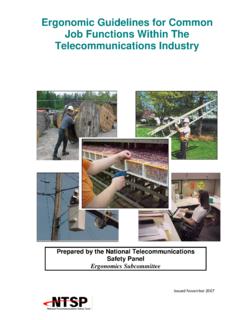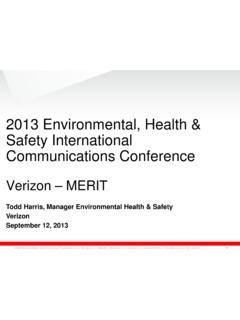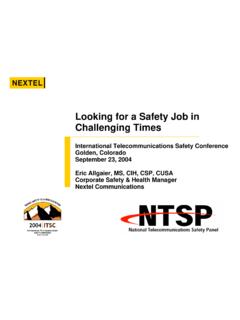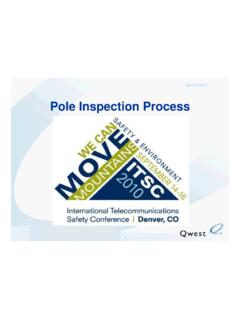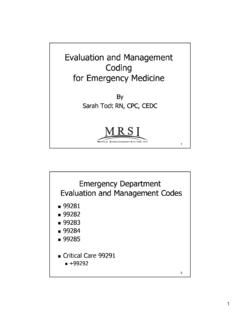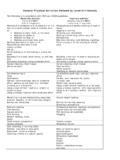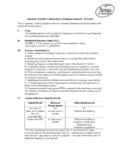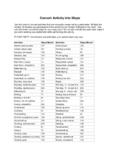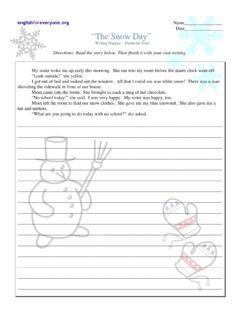Transcription of A fact sheet prepared by the Ergonomics …
1 A fact sheet prepared by the Ergonomics committee of the national telecommunications safety panel Through the OSHA and NTSP Alliance, NTSP developed this fact sheet for informational purposes only. It does not necessarily reflect the official views of OSHA or the Department of Labor. The information and material contained in this document has been developed from sources believed to be reliable. However, NTSP accepts no legal responsibility for the correctness or completeness of this material or its application to specific factual situations. By publication of this fact sheet , NTSP does not ensure that adherence to these recommendations will protect the safety or health of any persons or preserve property. Page 1 of 1 02/23/2011 Shoveling involves digging as well as moving loose materials such as dirt, gravel, or snow from one spot to another. Shoveling tasks are typically limited in duration. They involve a high degree of force and exertion and may take place in tight locations.
2 Ergonomic Tips Shovel blade edges should be properly shaped and kept sharp. Handles should be checked for splinters. Before shoveling, ensure you are wearing appropriate PPE including: work gloves; work shoes with sturdy soles; hard hat and high visibility vests if working near a roadway. Shoveling tasks should be performed as follows: 1. Consider stretching before attempting any physical exertion. Check with a medical professional if you have concerns regarding your physical abilities. 2. Keep your feet well separated for proper balance. Always keep your knees flexed. 3. Use the proper type of shovel for different shoveling tasks: a. Short handle shovels are used for spreading or laying dirt, etc. Hold this shovel with one hand close to the load for proper balance and to reduce stress on your back. b. Long handle shovels are used for digging. This shovel should also be held close to the load when carrying material.
3 C. An appropriate shovel should be used for moving different materials. Rounded or flat bladed shovels are typically used for loose material such as sand, while round bladed shovels are used for compacted or heavier substances such as earth or gravel. 4. When shoveling, keep the load close to the body and use the legs to support the weight. This action decreases the strain to the lower back and keeps the body in a balanced position. 5. Bend your knees but not your back while shoveling. Knees should be flexed so that your leg muscles take much of the load. 6. Care should be taken to allow for sufficient rest during shoveling tasks taking into consideration your health, and the environmental conditions such as heat and humidity. 7. Never twist your body. Twisting will only increase the risk of an injury. For ease, step in the direction you are throwing the material. 8. When you are digging, use the ball of your foot (not the arch) to press the shovel into dirt, gravel, etc.
4 Use a shovel that has a blade with a rolled step on the top part of the blade which helps distribute pressure over the larger area of the foot. 9. When shoveling wet, sticky or hard-packed materials, be sure to loosen the material before lifting your load. 10. Never use shovels as a pry bar or hammer. Applying water, grease or wax on the shovel blade will help to prevent materials from sticking. 11. The optimal throw distance is slightly over three feet. The load should be reduced if the task requires a longer throw. 12. Throw height should not exceed approximately four feet. 13. Caution should be used when shoveling snow, especially wet snow. Shoveling snow is strenuous to the heart and back and before attempting this task evaluate if you are up to the demand. If not, power machines or contracting the task may be appropriate. ADDITIONAL INFORMATION Exercises for Construction Workers OSHA e-Tool NTSP Ergonomic Guidelines and look for the job functions on Shoveling, page C-39.
5 NTSP OSHA Alliance
